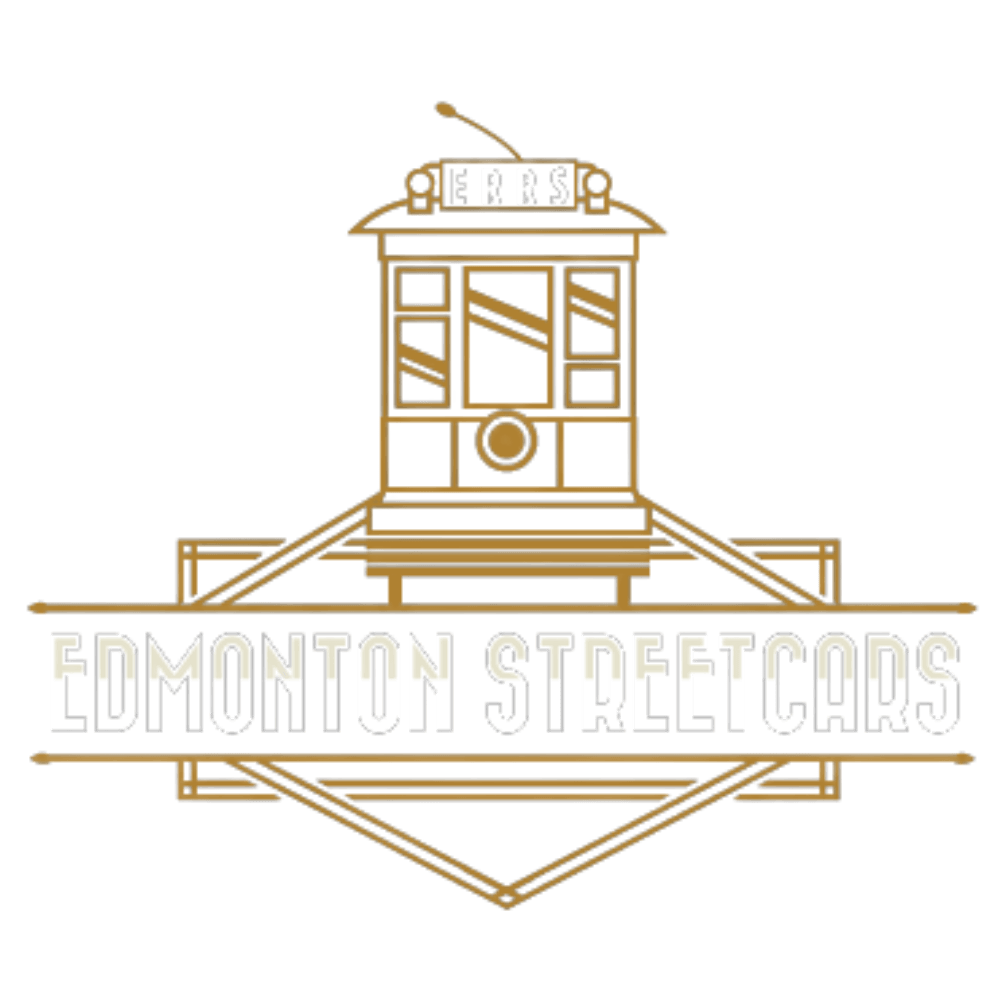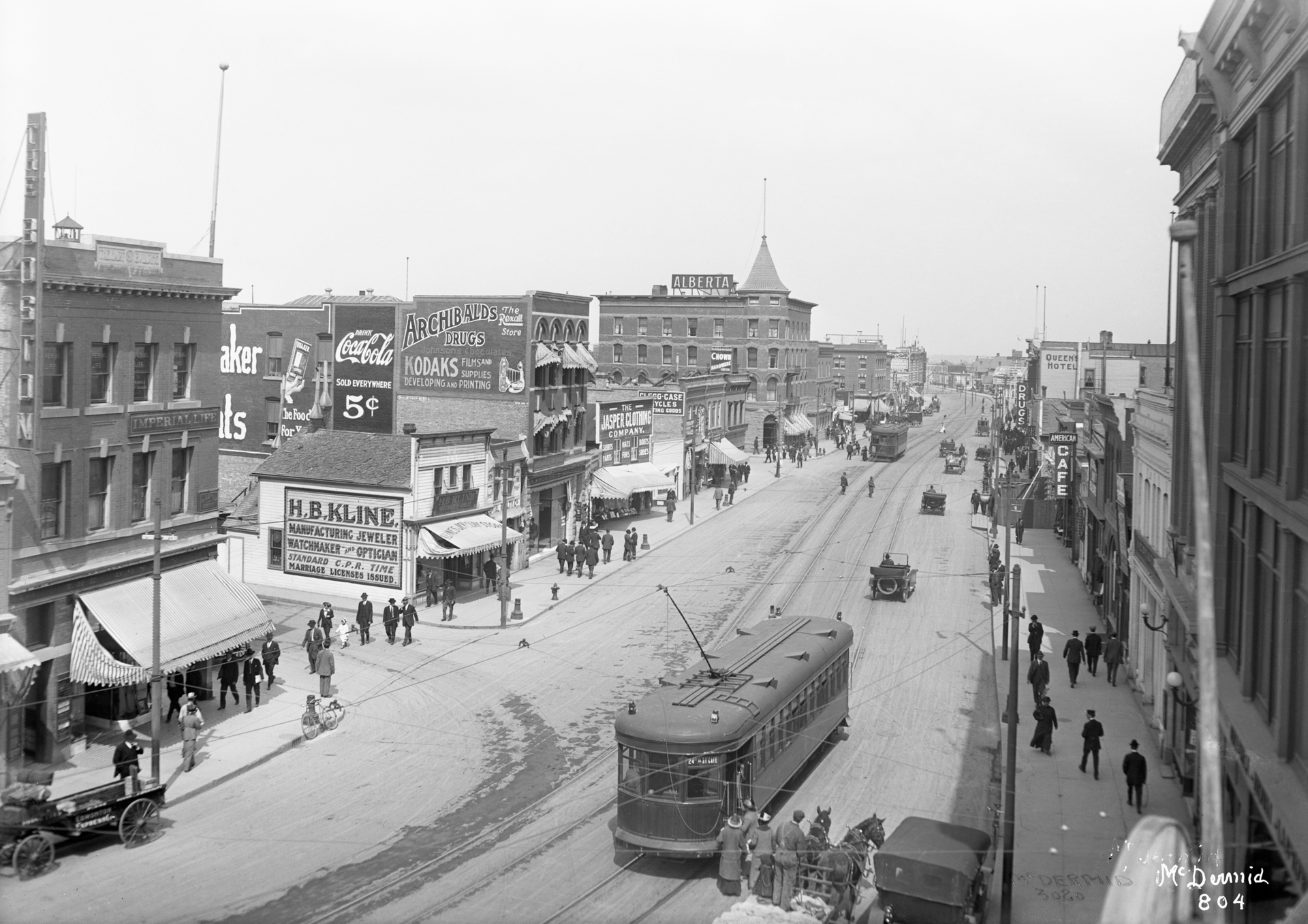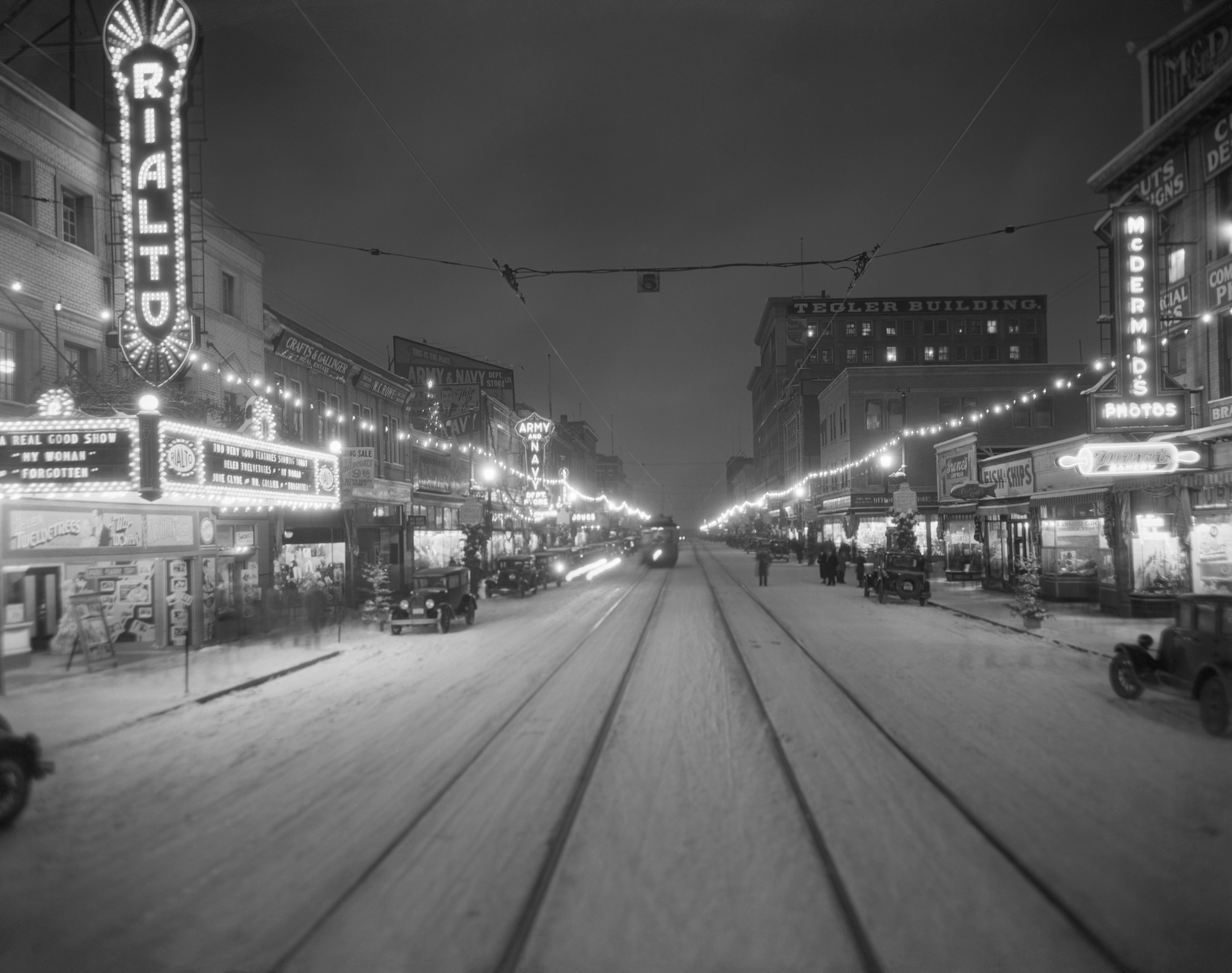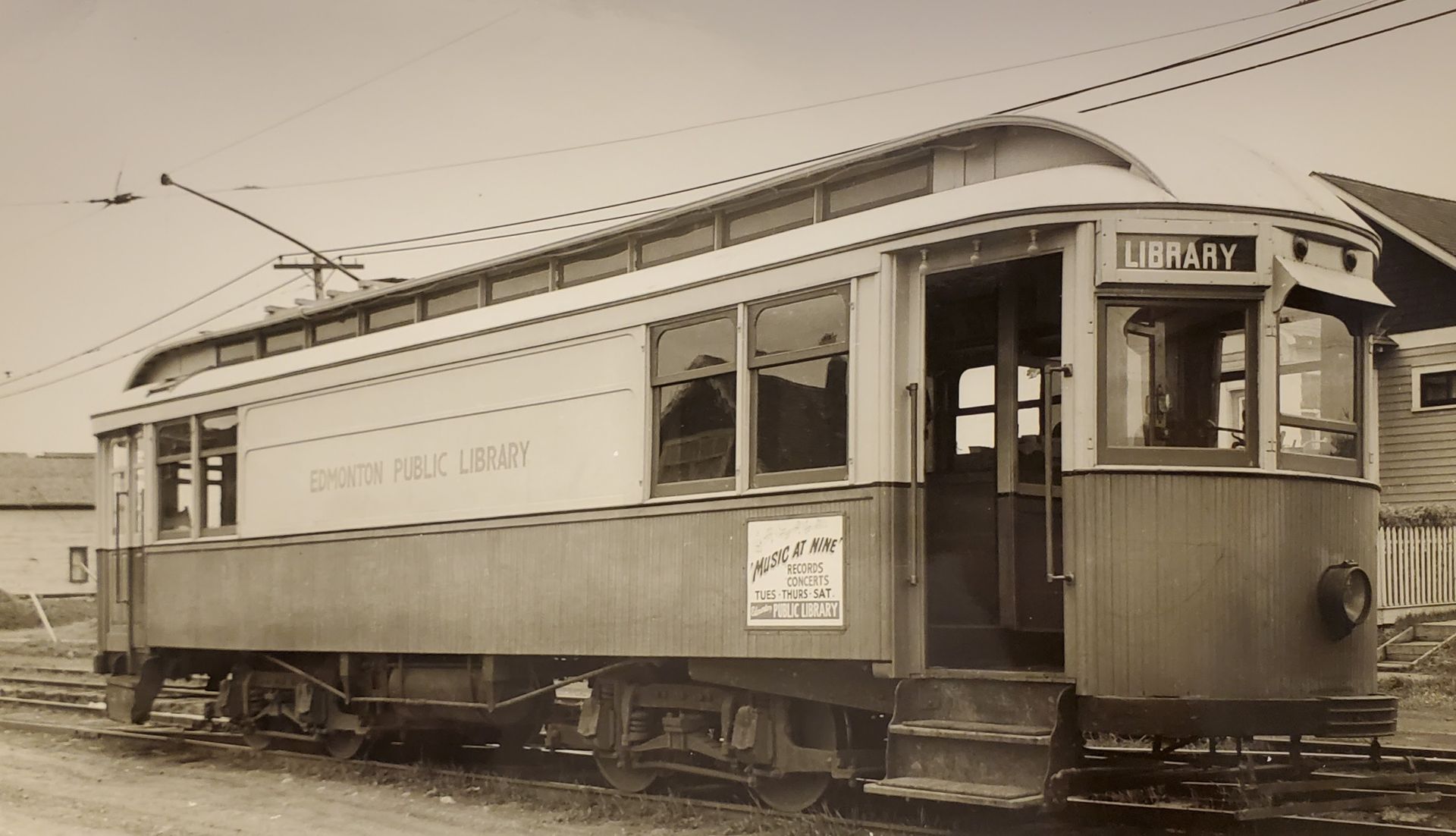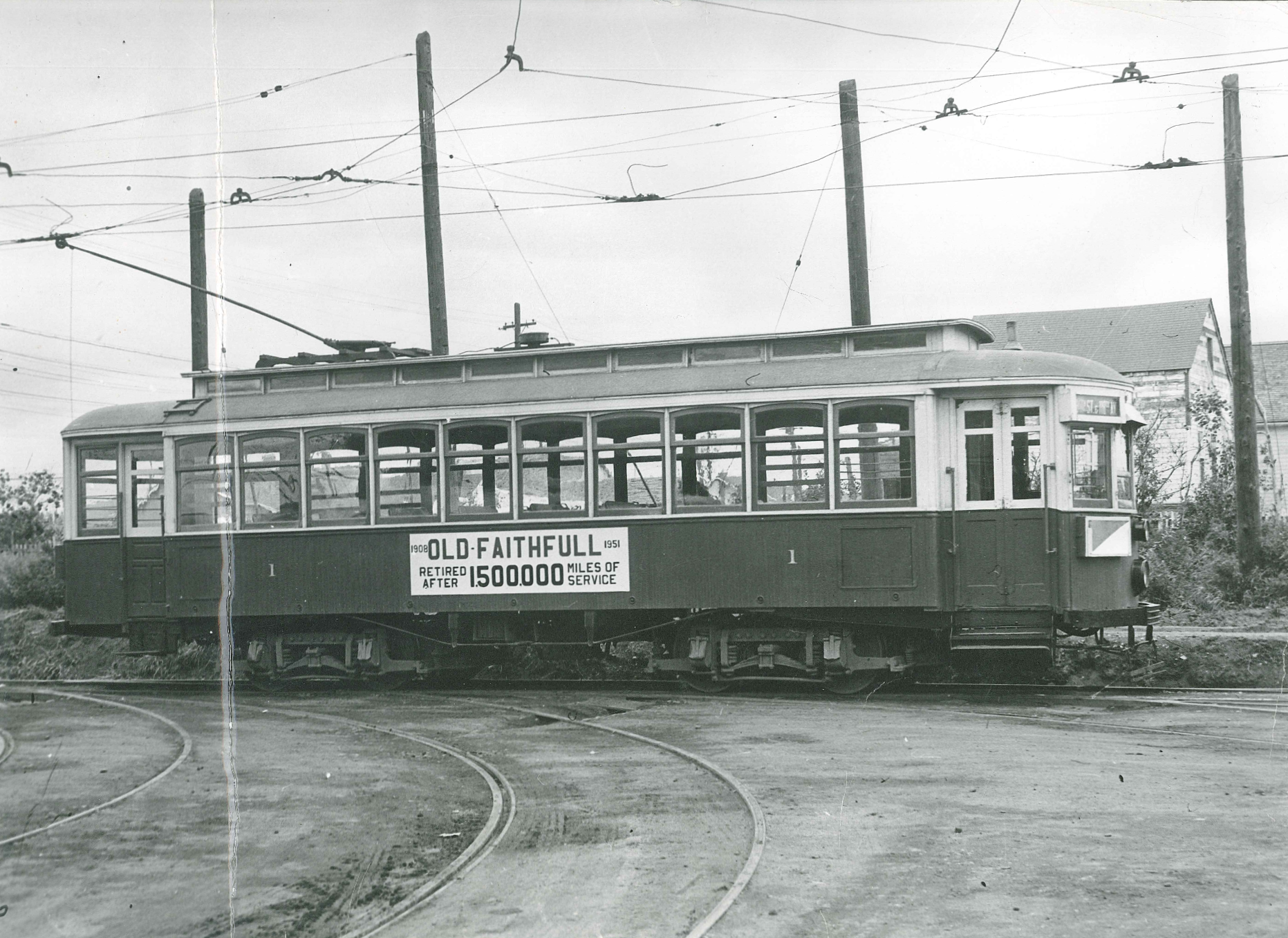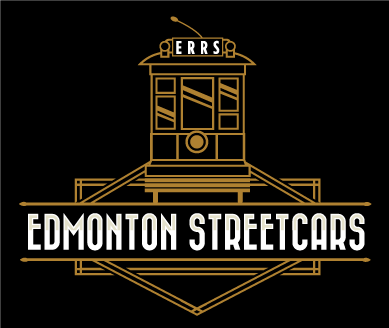
Edmonton Radial Railway
History of the Edmonton Radial Railway
Early Years (1908-1932)
The Edmonton Radial Railway started in 1908 with a total route length of 19 km (12 mi) served by two streetcars. The ERR's name stemmed from its radial, or "out-and-back", model; all streetcar lines converged at Jasper Avenue and 101 Street, and radiated outward to various areas of the city. Shortly prior to the start of service, Edmonton purchased the Strathcona Radial Tramway Company Ltd. for $135,000, thus gaining the ability to provide streetcar service to the City of Strathcona as well. Regular service commenced on November 9, 1908, with a fleet of four streetcars operating on 21 kilometres (13 mi) of track.
On its first day of operations, the ERR served approximately 3,000 riders. The service quickly grew in popularity as a mode of transportation, and it became known as "the pride of Edmonton". By 1911, daily ridership increased to around 4,784 passengers. Motormen, conductors, and other streetcar workers unionized in 1911, under the banner of the Amalgamated Association of Street and Electric Railway Employees of America (ATU) Local Division No. 569. The ERR served more than 10 million passengers in 1912, and Edmonton purchased 47 new streetcars. The original streetcar barn was replaced with a new barn in 1913, which would be in use until the system ceased operations in 1951. That same year, the High Level Bridge was completed, and provided an additional connection for streetcars between Edmonton and Strathcona; prior to its opening, the Low Level Bridge was the only river crossing with streetcar infrastructure.
A long-term expansion plan was presented to City Council by municipal staff in November 1912. The proposal called for 15 belt line routes, which would operate in circuits instead of straight (radial) lines. Council was told by city staff that the plan should provide adequate service for the next 50 years. Beginning in 1913, the plan was incorporated into expansion work that the ERR undertook. The plan never came fully to fruition; the ERR later reverted to a radial network model, and it never reached 15 routes.
The ERR was hard-pressed for employees during the First World War, because a number of its staff joined the military after war broke out; at least four of-whom died while overseas. Service was further hampered during this time by a major flood in 1915, an influx of European refugees, and the rise of jitneys (shared taxis). The ERR was forced to contend with a rising deficit, leading to the Edmonton Property Owners' Association demanding that the ERR be led by an independent board elected by residents, rather than unelected city staff. In September 1915, H. Milton Martin chaired an investigation which found that the ERR had suffered from notable financial mismanagement which created its deficit. The Martin Report made several recommendations, including a reduction of assets, lowering its operating expenditures, and transferring the ERR to an independent commission. Several changes were made to accounting practices, but key recommendations, such as the standing of an independent commission, were not implemented.
The end of World War I brought another influx of complains about the ERR, as residents criticized overcrowding, dirty streetcars, routes perceived as inefficient, and the prevalence of one-man streetcars. The ERR's Superintendent argued that these issues were caused by a number of factors out of his control; it was hard to obtain parts during the war, service was slowed by the number of railway crossings streetcars had to stop at, and two-man streetcar service was too expensive. This was on top of an increase in the number of passengers, as veterans began returning from the war.
Most streetcars were converted to allow for single-man operations by 1920. In 1917 or 1918, crossovers were installed at both ends of the High Level Bridge, so that streetcars could cross the bridge on the left-hand track. Single-ended streetcars only had doors on their right side, and in the event that people had to evacuate a streetcar while it was on the bridge, driving on the left-hand track allowed for the doors to open onto the middle of the bridge deck, instead of its edge. Some streetcars remained double-ended, but were only operated by one person.
The radial railway reached its greatest extent in 1920, with six full lines and two stub lines serving almost all sections of the city, and totaling 90.4 kilometres (56.2 mi) in length. The railway's busiest confirmed year of service was in 1929, during-which it served approximately 14.1 million passengers; Edmonton had approximately 74,000 residents at the time. In subsequent years, transit officials did not distinguish between streetcar and bus passengers when tallying ridership figures. Three years later, in 1932, trolleybus service replaced streetcars on the 102 Avenue stub line.
A list of the ERR's routes in around 1930 can be
accessed here.
Deterioration during the Great Depression (1933-1938)
The Edmonton Radial Railway seldom turned a profit, despite its large ridership. This was largely because passengers tended to remain on the streetcars for long periods of time, and many routes went through sparsely populated parts of Edmonton, such as single-track portions that served meatpacking plants in the city's fringes. These factors limited the turnover rate of passengers, and thus capped the amount of fares that routes could generate. Edmonton could not afford to properly maintain the streetcar system during the Great Depression. Although maintenance crews did their best to keep the streetcars in good condition, old tracks and streetcars could not be replaced, and the system could not be expanded to keep up with the Edmonton's growth.
City Council received a report from City Commissioner R.J. Gibbs in 1937 that detailed the deteriorating state of the streetcar system due to neglect during the 1930s, as a result of the city's poor financial state during the Great Depression. According to Gibbs, the city would need to invest a significant amount of money into replacing old streetcars, repairing and replacing streetcar infrastructure across the city, and expanding the service to newer parts of Edmonton. The report recommended that Council instead raise fares by 20%, invest the increased transit revenue to transition from streetcars to trolleybuses, and all future investments into the streetcar network. Gibbs also recommended that Council hire transportation exports to review his report before making a final decision.
Engineering consultant Norman F. Wilson was hired later in 1937, and he confirmed Gibb's findings in a 1938 report to Council. The ERR had failed to break even during most of its existence, and Wilson found that an increase in the fare from five rides for 25 cents down to four rides for 25 cents could not only cover the ERR's operational costs, but also provide a surplus to fund future service expansions. However, Wilson warned that "streetcars everywhere are a declining industry," predicting that the rising number of privately owned automobiles would slow the growth of transit usage. The report recommended that Edmonton begin its switch to trolleybuses by purchasing six of them to serve a route between Whyte Avenue and downtown. The city ordered six trolley buses in 1939, prior to the start of the Second World War.
Wilson also recommended that the streetcar tracks on the upper deck of the High Level Bridge be removed, and the deck repurposed for trolley buses. The city sent an engineer to Montreal and Toronto to discuss the idea with CPR and Canadian Bridge Company engineers, but nothing further happened immediately.
Opponents to the abandonment of streetcars argued that the trolley buses were less comfortable for riders, not more comfortable as Council had been told by experts, and that trolley buses only provided faster service than streetcars because the distance between stops was increased. Commissioner Gibbs and ERR Superintendent Thomas Ferrier opted for a gradual shift away from streetcars; both to make sure ridership was positively impacted by the change, and also to see how riders reacted to the trolley buses. The trolley buses proved highly successful when they began service, with the peak passenger load increasing by 100% instead of 50% as planners had anticipated. This unanticipated demand forced the ERR to order three additional trolley buses, and make the route shorter than planned to reduce the number of people using use it.
World War Two (1939-1945)
During the Second World War, Edmonton became a key air hub for the Allied cause. Blatchford Field was chosen by the British Commonwealth Air Training Plan to host an observer school and an elementary flight training school, and Edmonton served as a key stopping point for Lend-Lease aircraft travelling from the United States to the Soviet Union; thousands of Edmontonians became employed in the aircraft repair sector. An influx of Americans called Edmonton home starting in 1942, when Edmonton became the southern hub of the Alaska Highway and the Canol pipeline. Local workers and American soldiers alike primarily relied on the Edmonton Radial Railway to get around the city, and the ERR's ridership spiked by 40% between 1940 and 1942.
The transition away from streetcars was slowed by the war, as Edmonton struggled to procure buses in the face of wartime supply restrictions. Edmonton was forced to build new tracks to provide high-in-demand streetcar service to Aircraft Repair Ltd, which employed approximately 3,000 residents. When streetcar No. 28 caught fire in 1943, the ERR opted for a lengthy three-year refit instead of scrapping it, due to the severe shortage of rolling stock.
The ERR reintroduced conductors on October 4, 1943, many of whom were women called conductorettes, to sell tickets and issue transfers on streetcars that served busy routes. Conductorettes were primarily stationed in the rear vestibules of streetcars on major routes, and riders were expected to board at the rear of these cars to keep the front door clear for disembarking passengers. The first day of the program was declared an "unqualified success" by transit Superintendent Thomas Ferrier, and the Edmonton Journal noted that "observers were impressed by the alertness with which the women operated the rear doors and sold tickets."
To indicate that a conductorette was on a streetcar, and riders could board at the back to keep the front door clear for those exiting the car, 'V for Victory' placards were placed in the front and rear vestibule windows. Conductorettes became the first women allowed to join ATU Local Division No. 569, which had previously barred women from joining since its founding in 1911. The number of conductorettes rose to fifty-nine by January 1944, as ridership numbers continued to increase sharply. Aside from selling tickets, they also did tasks such as operating track switches at busy termini to speed up service. They were also promised by City Commissioner R.J. Gibb that they would be able to train as streetcar operators as long as they passed operations tests and met the physical requirements.
Despite the difficulties encountered by Edmonton during the war, it still managed to replace some streetcar lines with bus service. Streetcar operations along 95 Street, Scona Hill, and the Low Level Bridge were replaced by buses in 1939; this was followed by Bonnie Doon in 1940, Whyte Avenue (between 104 and 94 Street) in 1944, and Highlands, along with the Rossdale stub line, in 1945.
The ERR tried to find ways to help improve the spirits of local residents during the war. Librarian H.C. Gourlay proposed the introduction of a library car, and streetcar No. 14 was converted into a mobile library to serve residents in outlying neighbourhoods. The royal blue streetcar, which had a capacity for 2,000 books and was fitted with wooden bookcases that were secured to its walls, entered service in October 1941. The ERR constructed short sidings in certain neighbourhoods so that the streetcar could park without blocking transit services. On its first day of service, 700 residents visited it in Calder; more than half of them were first-time borrowers, and three quarters were children. By early December, 1941, the streetcar library lent more than 9,500 books, and signed up over 4,000 adults and 1,000 children with new library memberships.
Final Years of Service (1946-1951)
After the war ended, Edmonton's transition from streetcars to buses continued to be hampered by further increases in ridership, and difficulties in procuring buses. The city constructed more streetcar tracks as late as 1946, as streetcars continued to serve as an important backbone for the transit service. The Edmonton trolley bus system gradually replaced streetcar service on most Edmonton Radial Railway routes, and gas and diesel buses filled the remaining gaps. The Edmonton Radial Railway's name was changed to Edmonton Transportation Service in July 1946 to reflect the shift away from streetcars, and just one year later it was renamed to Edmonton Transit System.
Despite earlier promises to let them become operators, the ERR announced in April 1945 that it would phase out the conductorette program, and according to transit Superintendent Thomas Ferrier, they would be “released just as quickly as the department could do without them.” The end of the war meant a gradual return to normal transit operations, while an influx of applications from veterans further reduced the staffing pressure. All conductorettes except four were laid off by April 28, and the remaining four were let go in August. Despite being let go, the conductorettes were recognized by riders and transit staff for playing an important role in keeping the ERR functioning during the war. Transit union members unanimously passed a formal motion of thanks on May 28, in-part stating that the conductorettes were: "soldiers of real merit on the home front by helping to master successfully a terrific transportation job." Superintendent Ferrier remarked: "If it hadn’t been for their help, our services would have been handicapped greatly."
Streetcar service in Calder became isolated from the rest of the streetcar system in May 1948, when the tracks on 124 Street, south of 118 Avenue, were paved over. A small temporary storage yard was constructed at 118 Avenue, and seven passenger cars, a sweeper car, and the library car were parked there before the paving occurred. Buses were used to transport passengers between the Calder stub line and the northern terminus of the Red-and-Green line, which previously ran uninterrupted into Calder. A streetcar was always parked at 118 Avenue to serve as a heated shelter for people waiting either for a bus, or a Calder streetcar. The library streetcar was parked at a small spur on 127 Street, south of 125 Avenue, to serve the neighbourhood of Sherbrooke. Streetcar ridership across the city steadily rose during this time, but noticeably fell after City Council approved a fare increase to address the operating deficit.
In 1949, voters approved a plebiscite for the streetcar tracks to be replaced by four lanes of road for vehicles. Project delays caused the capital costs to increase, and the proposal went back to voters with a larger budget in a 1950 plebiscite. A majority of voters approved it once again, but the approval threshold fell below the two-thirds minimum needed for the plebiscite to pass, and the project was cancelled.
The Calder stub line closed permanently in August 1949, and all nine streetcars on this stub line were scrapped. In that same month, streetcar service on Whyte Avenue was replaced by bus service, and the new south terminus for streetcars was at 84 Avenue and 109 Street. After these closures, only the Blue Route and the Blue and White Route remained in service, totalling 17 miles (27 km) in length. In its final configuration, the service went between a loop at 109 Street and 84 Avenue, and another loop at 66 Street and 124 Avenue, via the High Level Bridge.
On September 1, 1951, Edmonton streetcar No. 1 – one of the first two streetcars ordered by Edmonton – performed a ceremonial 'last run' across the High Level Bridge at around 8 pm. It carried Mayor Sidney Parsons and other invited guests from Jasper Avenue and 97 Street, to the loop at 84 Avenue and 109 Street. A number of the dignitaries on board took turns driving No. 1, including Lieutenant Governor John J. Bowlen, who had once been a conductor in Boston's street railway system. From there, they took a bus to the opening ceremony for the new Strathcona bus garage, which was built at a cost of $500,000. Around 1,000 people watched the streetcar trip, which marked the closure of the Edmonton's streetcar system.
Streetcar service actually continued into September 2, when Car No. 52, operated by Motorman George Evans, made the final trip across the High Level Bridge at approximately 1 am. Transit Superintendent Thomas Ferrier and his wife, who kept themselves awake after the official ceremony ended, were among the five passengers on board – marking the final revenue streetcar trip operated by Edmonton Transit. The agency continues to operate bus and light rail lines as Edmonton Transit Service.
The Edmonton Radial Railway Society operates on Treaty 6 territory, a traditional meeting grounds, gathering place, and travelling route to the Cree, Saulteaux, Blackfoot, Métis, Dene and Nakota Sioux. We acknowledge all the many First Nations, Métis, and Inuit whose footsteps have marked these lands for centuries.
